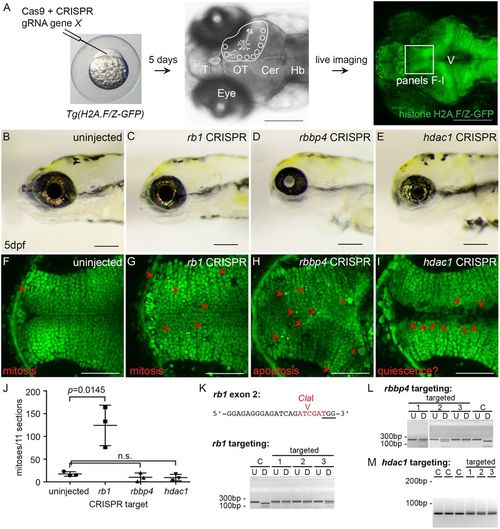
CRISPR somatic targeting-live imaging assay to test chromatin remodeler function in neural cell populations during brain development. Somatic inactivation recapitulates germline mutants and reveals distinct requirements for rb1, rbbp4 and hdac1 in neural progenitor proliferation, differentiation and survival. (A) CRISPR targeting in histone H2A.F/Z-GFP fusion line and dorsal view, and confocal live imaging of GFP in the brain at 5 dpf. (B) 5 dpf wild-type larvae. (C-E) Gross defects in 5 dpf rb1 (C), rbbp4 (D) and hdac1 (E); CRISPR targeted larvae recapitulate germline phenotypes. (F) Confocal imaging in the optic tectum in the brain of a live 5 dpf larva. Section through the ventral region of the optic tectum. Mitotic figures are rarely captured in uninjected larvae at this level of the tectum (red arrowhead). (G) Tectum in rb1 CRISPR-targeted larva shows cells with nuclei containing condensed chromatin (red arrowheads) scattered throughout the postmitotic region of the tissue. (H) Tectum in rbbp4 CRISPR-targeted larva shows intense, punctate fluorescence in presumed apoptotic nuclei (red arrowheads) and abnormally large, irregular nuclei (asterisks). (I) Tectum in hdac1 CRISPR targeted larva shows an overall reduction in size and cell number. Enlarged nuclei with faint GFP line in the ventricle (red arrowheads) are observed. (J) Quantification of M-phase phosphohistoneH3-positive nuclei in the optic tectum in three uninjected control, rb1-, rbbp4- and hdac1-targeted larvae. Targeting experiments were replicated three times for rb1, and two times for rbbp4 and hdac1. Plot shows mean±s.e.m. number of positive nuclei in 11 sections, in three biological replicates. The number of M-phase nuclei in rb1-targeted larvae is significantly different from that in control larvae. rb1, P=0.0145; rbbp4, P=0.3024; hdac1, P=0.1841; n.s., nonsignificant (two-tailed unpaired Student's t-test). (K-M) PCR genotyping shows highly efficient mutagenesis in the three CRISPR-targeted individuals used for quantification. C, control uninjected individuals. Location of rb1 exon 2 CRISPR gRNA and ClaI enzyme site overlapping Cas9 cut site (K). U, undigested PCR amplicon; D, ClaI-digested PCR amplicon surrounding exon 2. rbbp4 and hdac1 targeting was performed with the gRNAs used to isolate loss of function alleles described in Fig. 5. rbbp4 targeting (L). U, undigested exon 2 PCR amplicon; D, SmlI-digested exon 2 PCR amplicon. In the hdac1-targeted larvae the diffuse PCR amplicon band on the gel in targeted individuals correlates with efficient mutagenesis (M). Scale bars: 200 µm (A-E); 50 µm (F-I).
|

